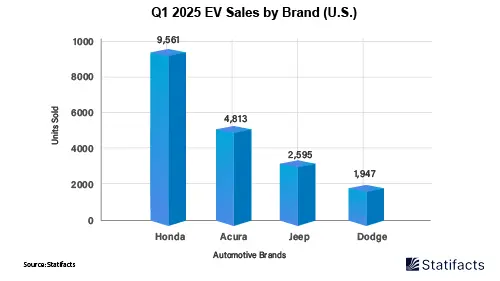
25 June 2025
U.S. electric vehicle sales reached approximately 300,000 units in the first quarter of 2025, up 11.4% year-on-year, or 7.5% of total new vehicle sales. General Motors accounted for upwards of 30,000 electric vehicles sold, leading all non-Tesla brands, and almost doubling their Q1 production output from 2024. During this time, the number of new electric vehicle (EV) models available in the U.S. increased to 69, up from 49 one year ago. Despite high sales, nearly 60% of units constitute electric vehicle lending, which indicates how important financing is for improving electric vehicle adoption due to affordability and charging costs, in the first quarter.

The graph above shows the electric vehicle sales by different brands such as Honda, Acura, Jeep, and Dodge in the U.S. Legacy manufacturers, particularly GM and Honda, have accelerated production and sales to take market share away from Tesla. The scale suggests rapid diversification of the EV lineup, where non-Tesla participants are now responsible for a large percentage of the sales.
Tesla is still in the lead but now faces challenges. The top models of Ford and Chevrolet $10,000 top models, indicate mainstream adoption by breaking the 10,000 units sold barrier for each. The introduction of the Honda Prologue suggests an even faster OEM pivot from concept vehicle to volume production.
All indicators show a rapid evolution of the market (data suggest new model variety and also evolving financial constructs such as leasing and AI-enabled underwriting), suggesting confidence from both consumers and the industry in electric vehicle financing.
Insightful analysis
As 60% of Q1 electric vehicle sales in the US chose leasing, rather than purchasing, lenders, both OEM-affiliated and not, are developing these partnerships more into customized financing solutions, especially as tariffs and affordability become more challenging. The growth of leasing and customized automotive loans shows how important flexible financing can be in reducing barriers for electric vehicle buyers.
Industry leaders are using AI to fast-track loan origination and lower risk. J.D. Power's Patrick Roosenberg describes AI as able to untangle traditionally paper-oriented underwriting processes. In turn, the financial technology firm Earnix has said AI-driven analytics has opened up resilience and profitability in electric vehicle sales as unit margins continue to shrink. Global automakers such as GM and Toyota are using AI to offset cost pressures from tariffs with cost-effective operations. Overall, AI is improving access to credit, speed to market, and accuracy of underwriting, all of which are driving electric vehicle market expansion.
Electric vehicles and their impact on the automotive industry
Electric vehicles are quickly transforming the automotive sector in the U.S. and changing how consumers buy and finance cars. In Q1 2025, brands like Honda, Toyota and Dodge are leading the electric vehicle sales numbers due to increased loan volumes, better credit scores, and larger monthly payments. Automakers are using in-house lenders, and AI-based credit score systems, to streamline the process. The federal incentives and expanding used EV market provide an additional lift to the adoption of EVs. Both this shift from mode and method of purchasing the car has sped up an even larger transition to cleaner and technology-based mobility.

There are many variations of passages of Lorem Ipsum available, but the majority have suffered alteration in some form
URL TO BE USED AS REFERENCE LINK:
Placeholder content for this accordion, which is intended to demonstrate the .accordion-flush class. This is the first item's
accordion body.
Placeholder content for this accordion, which is intended to demonstrate the .accordion-flush class. This is the second item's
accordion body. Let's imagine this being filled with some actual content.
Placeholder content for this accordion, which is intended to demonstrate the .accordion-flush class. This is the third
item's accordion body. Nothing more exciting happening here in terms of content, but just filling up the space to make it look, at least at
first glance, a bit more representative of how this would look in a real-world application.
Do you still any question?
Feel free to contact us anytime using our contact form or visit our FAQ page.
Your contact to the Infographics Newsroom
